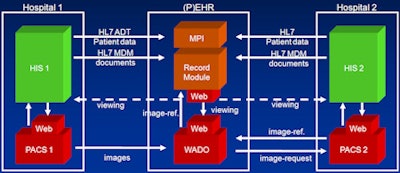
Interest is percolating in the use of personal electronic health records (EHRs). But integrating radiology images and information with these records may be a difficult hurdle to clear, if the experience of Heidelberg University Hospital in Germany is any indication.
Due to a lack of vendor support for elements of the Integrating the Healthcare Enterprise (IHE) initiative, the German team had to blaze their own trail in attempting to integrate their RIS/PACS with a pilot personal electronic health record project in the Rhein-Neckar region of Germany. While they were able to achieve some positive results, it required a complex internally developed system and a number of tradeoffs along the way, according to Oliver Heinze, who presented the institution's findings during a scientific session at the 2010 European Congress of Radiology (ECR).
"We have a very highly complex, message-based interaction between several systems ... but it's currently highly dependent on local conditions and not as generic as we originally intended," Heinze said.
Currently in the pilot phase and encompassing one general practitioner, one 400-bed hospital, and one 1,800-bed university hospital, the personal EHR project aims to support integrated care with a strong focus on the patient, provide improved quality of diagnosis and treatment, avoid multiple exams, and reduce cost and optimize the cost/benefit ratio, Heinze said.
In concept, the personal EHR contains data input by the patient and is fully controlled by the patient; it suffers, however, from having no automated import capability from other systems, Heinze said. As a result, the researchers sought to combine the advantages of the electronic health record and the personal electronic health record.
Two interfaces have currently been established with the hospital: an HL7 Admission, Discharge, and Transfer (ADT) messaging interface transfers patient data and an HL7 Medical Document Management (MDM) interface transfers documents.
"A physician from one institution is able to see documents from another [institution] by clicking on a button via the Web browser," he said.
Adding images to the personal EHR was challenging, requiring navigation of a number of challenging functional, privacy, and security requirements, Heinze said. The group initially sought to make use of the IHE initiative -- including the XDS-I Cross-enterprise Document Sharing for Imaging integration profile -- to accomplish the goal of integrating RIS/PACS with the personal electronic health record.
"However, this won't work at the moment because many of the different vendors don't support the needed profiles," Heinze said.
Forced to solve the problem in another way, the researchers developed an implementation concept using a "pull" model involving HL7 and DICOM messaging. A centralized DICOM Web Access to DICOM Persistent Objects (WADO) module in the personal electronic health record registers images and understands which PACS they're stored on.
"This is, of course, a highly complex flow of data, and we have to establish two different kinds of HL7 interfaces in order to get the patient identification and other information [as well as] the accession number of the case," he said. "This information has to be there at the WADO, and then the WADO can do the DICOM request and finally register the document in the record."
 |
| Patient allocation, document sharing, and integration of PACS. Image courtesy of Oliver Heinze. |
This approach has the disadvantage, however, of depending on the local conditions of the partner hospitals, Heinze said. In addition, sometimes a link can exist inside the record but the image is not available, he said.
"Also, reallocation of images to another patient can only be communicated [in a] proprietary [way]," he said.
On the bright side, the system offers better workflow integration than provided by a teleradiology system; images will be directly related to the case and patient and will appear immediately inside the record, Heinze said. In addition, it doesn't require active sending or importing of images.
Ultimately, the proliferation of IHE will go a long way to solving these difficult integration problems, Heinze said.
"When the time is right, we will do this solution," he said.
By Erik L. Ridley
AuntMinnie.com staff writer
April 5, 2010
Related Reading
EU tackles legal issues of e-health, teleradiology, March 6, 2010
Regional RIS/PACS maximizes radiology service in Spain, March 4, 2010
Radiology IT explores new frontiers, February 18, 2010
ACR: Use of teleradiology triples from 2003-2007, October 20, 2009
IHE's XDS-I profile may help with CD import dilemma, April 14, 2009
Copyright © 2010 AuntMinnie.com


















